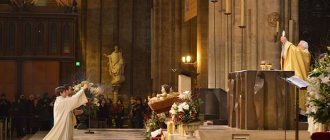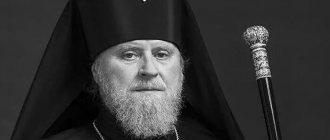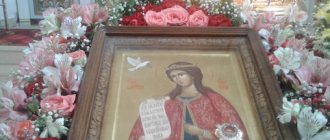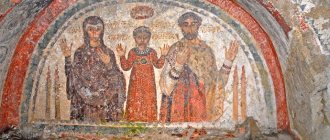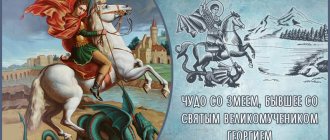| VMC. Euphemia. Fresco of the Church of the Annunciation. Gračanica. Kosovo. Serbia. Around 1318 |
Euphemia of All Praise
(+ 304), Great Martyr Memory July 11, September 16
Saint Euphemia was the daughter of Christians - Senator Philofron and Theodosius. She committed martyrdom in the city of Chalcedon in 304, during the persecution launched against Christians by the emperor Diocletian.
The Chalcedonian ruler Priscus sent out an order to all residents of Chalcedon and its environs to come to the pagan festival to bow and sacrifice to the idol of Ares, threatening with great torment those who did not fulfill the order. During this unholy festival, 49 Christians hid in one house, where they secretly performed Divine service to the True God. Among the worshipers was the young girl Euphemia. Soon the whereabouts of the Christians became known, and they were brought to Priscus for an answer. For 19 days, the martyrs were subjected to various tortures and tortures, but none of them wavered in their faith and agreed to sacrifice to the idol. The angry ruler, not knowing any other way to force Christians to renounce, sent them to the Emperor Diocletian for trial, but separated the youngest from them, the maiden Euphemia, hoping that she, left alone, would not stand the test.
Saint Euphemia, separated from her brothers in faith, fervently prayed to the Lord Jesus Christ that He Himself would strengthen her in the upcoming feat. At first Priscus persuaded the saint to renounce, promising earthly blessings, then he gave the order to torture her. The martyr was tied to a wheel with sharp knives, which, when rotated, cut off pieces of her body. The saint prayed loudly. And so, the wheel stopped by itself and did not move despite all the efforts of the executioners. An Angel of the Lord descended from heaven and took Euphemia off the wheel and healed her of her wounds, while the saint joyfully thanked the Lord.
| Icon “Memory of the miracle of the Military Medical Center. Euphemia the All-Praised, to whom Orthodoxy was established (451).” |
Without coming to their senses miraculously, the tormentor ordered the soldiers Victor and Sosthenes to throw the saint into a red-hot furnace.
But those, seeing two formidable Angels in the flame, refused to carry out the orders of the ruler and themselves believed in God, Whom Euphemia worshiped. Having declared themselves Christians, Victor and Sosthenes boldly went to suffer. They were given to be eaten by wild beasts. During the execution, they cried out for God’s mercy, so that the Lord would accept them into the Kingdom of Heaven. Hearing the heavenly Voice calling them, they departed into eternal life. The animals didn’t even touch their bodies. Saint Euphemia, thrown into the oven by other soldiers, remained unharmed. With God's help, she emerged unharmed after many other tortures and tortures. Attributing this to magic, the ruler ordered a new ditch to be dug, filled it with knives, and covered it with earth and grass on top so that the martyr would not know about the execution prepared for her; but even here Saint Euphemia remained unharmed, having easily passed over the ditch. Finally, she was condemned to be devoured by animals in the circus. Before her execution, the saint began to ask the Lord to grant her death. Not a single beast released into the arena rushed at the saint. Only one bear inflicted a small wound on her leg, from which blood flowed, and the Holy Great Martyr Euphemia died immediately. At this time, an earthquake occurred, the guards and spectators fled in fear, so that the saint’s parents were able to take her body and bury her with honor near Chalcedon.
| Relics of St. Great Martyr Euphemia All-Praised. Patriarchal Cathedral of the Great Martyr. George the Victorious of the Patriarchate of Constantinople |
Life and martyrdom
Senator Philofron and his wife Theodosia, who lived in Chalcedon at the end of the third century, converted to Christianity and raised their children in the glorification of the living God, Jesus Christ. Their daughter Euphemia was a particularly zealous Christian, about whose life before the period of the appearance of the feat of fidelity to the Savior, nothing is known.
Great Martyr Euphemia of All Praise, Chalcedonian
Emperor Diocletian was known as an ardent supporter of paganism and encouraged the persecution of Christians. The Chalcedonian ruler Priscus fully supported the emperor's policies and took all measures to destroy the smallest manifestation of Christianity in the area.
In order to identify fans of Christianity among the population, Priscus organizes a holiday in honor of the pagan idol Ares, and, under pain of death, orders all residents of the Chalcedonian district to appear and make sacrifices in front of the idol temple.
Read about persecution:
- Persecution of Christians
- Russian Orthodox Church during the period of persecution
During the holiday, 50 worshipers of the living God secretly gathered to worship and glorify Jesus Christ, among them was the young maiden Euphemia.
Ruler Priscus was informed about the secret meetings of Christians, he ordered everyone to be arrested. For 19 days, with terrible torture, the pagans tried to force the faithful worshipers of God to renounce their faith, but they were unable to cope, and sent 49 people to trial before the emperor, leaving the girl behind. The executioners hoped that without the support of her comrades the girl would break, but they had to bitterly regret their decision.
Prayers
Troparion, tone 3 from the Greek Menaion
[2]
You have greatly rejoiced the Orthodox / and you have put to shame the evil ones, / Euthymie, the virtue of Christ, / You have confirmed the dogmas of the Fourth Council, / like the fathers who confessed kindly. / To the martyr. Glorious one, / pray to Christ God / to grant us great mercy.
Troparion, tone 4
[3]
Having loved Christ your bridegroom,/ and having prepared your light,/ having shone with virtues, O all-praised Euthymia,/ you have ascended to marriage with Him,/ having received the crown of suffering from Him./ But deliver us from troubles , // who honor your memory with faith.
Kontakion, tone 6
Deeds in suffering, deeds in faith/ you laid down for warmth for Christ, your Bridegroom./ But even now, like heresies, and enemies staggering/ under the feet of our army, subdue the prayers of the Mother of God,/ I And from the six hundred and thirty God-bearing Fathers / received the limit, // and preserving, all-praising.
Kontakion, tone 4
In your suffering you labored well/ and after death you sanctified us with miracles, O all-praised one./ Thus we sing of your succession,/ by resorting to your Divine Church by faith,// so that we may be delivered from the ailments of the soul and from miracles We will draw grace from you
.
Miracles
The Great Martyr Saint Euphemia the All-Praised, whose life took place among Christians, was constantly in prayer and glorification of Jesus Christ, asking Him for protection, salvation and liberation. Ruler Priscus seduced the girl with earthly blessings and frightened her with terrible torments, but everything turned out to be in vain.
Wheel of Misery
In terrible anger, the ruler ordered the maiden to be tied to a wheel, which was spinning over sharp knives; they literally tore the tender body into pieces, but the executioners and everyone present heard not cries of suffering, but a prayer of gratitude.
Suddenly the wheel stopped, and with the help of an Angel who appeared, the young maiden found herself on the ground, completely restored, without a single scratch. Ruler Priscus announced that this was the mercy of a pagan idol, giving the last chance to a Christian woman. After refusing to praise the idol, the executioners began the next torture.
Adoption of Christianity by pagan warriors
The warriors Victor and Sosthenes were ordered to throw the girl into a white-hot oven. While still pagans, the soldiers rushed to carry out the order, but suddenly among the tongues of fire they saw angels walking and refused to be accomplices in the execution.
At the same moment, Victor and Sosthenes called on Jesus as Savior, publicly calling themselves Christians. Enraged, the ruler orders the rebels to be thrown into a cage with hungry animals. Victor and Sosthenes cried out to God, and their souls were taken to heaven a moment before the animals approached their bodies.
New torment and miracle of liberation
Priscus's order was carried out by other soldiers, but, thrown into a red-hot furnace, the Great Martyr All-Praised remained unharmed.
The ruler of Chalcedon, declaring what was happening to be witchcraft, came up with a new execution. Spears and knives were placed in the dug ditch with the tips up, all of which was covered with grass and a small layer of earth. Unaware of the new torture, the girl easily walked across the ditch, surviving.
Tired of the torment of the VMC, Euphemia asked God in prayer for liberation and acceptance into the Kingdom of Heaven, realizing that the tormentors would not stop until they destroyed the Christian faithful to the Lord.
The whole arena witnessed a miracle when predators approached the girl thrown into a cage with animals, affectionately licked her hands and behaved like pets.
Great Martyr Euphemia in the lions' den
Only the claw of a huge bear injured a vein on the captive’s leg, she bled to death, quietly retreating to Heaven. At that same moment, the earth began to tremble, guards and spectators rushed from the arenas in all directions during the earthquake, which made it possible for Christians to take the body of the sufferer and bury it in the ground not far from the city.
Read about miracles:
- Miracle of the Descent of the Holy Fire
- Miracles in Orthodoxy: stories and evidence
- Conversations with children about the miracles of St. Nicholas
Death in the name of the Lord
Priscus came up with many tortures for the captive, whom he considered a sorceress. It was never possible to break her, and all the torture did not harm her. The saw with which they wanted to saw her became dull, the snakes in the ditch where they threw her did not bite, but carried her to the shore. Then they took the martyr to the circus to put her to death as usual for Christians, to be torn to pieces by wild beasts. In prayer, she asked God to accept her sacrifice and rest her soul in the villages of martyrs and saints. Lions and bears released into the arena licked the feet of the one they were about to tear apart. Only one small wound was bleeding on her body. Finally, the Almighty condescended to pray, and she died, proving with her life “the weakness of demons and the madness of the tormentor.” An earthquake began immediately. Pagan temples and fortress walls collapsed, burying the wicked. Everyone fled, and the parents took their daughter and buried her near the city. It was on that spot that the first temple was subsequently erected in honor of the saint.
Posthumous miracles
More than 150 years passed after the death of Euphemia, Orthodoxy reigned in Chalcedon.
According to the historian of that time, Evagrius Scholasticus, the Great Martyr appeared in dreams from time to time to people endowed with special piety, inviting them to the church built in her honor to collect “fruits.”
The silver reliquary storing holy relics had a special hole into which a sponge was lowered. The priest gently moved it along the saint’s body and lifted the sponge moistened with blood. Holy blood was collected, poured into small vessels and distributed to people for healing from many diseases.
Emperor Mauritius, who lived in 594, considered the miracle to be ordinary rumors and decided to conduct his own investigation. The amount of blood he received was so great that the incense filled the entire temple. The emperor publicly repented of his unbelief.
The miracle of Euphemia the All-Praised was revealed during the Fourth Ecumenical Council, which took place in the church nearby the holy relics. At that time, disagreements arose about the nature of Jesus Christ. The Monophysites, taking the position of heretics, refused to recognize Jesus as a man, attributing to Him only the nature of God.
To avoid unrest and strife, on the advice of Patriarch Anatoly of Constantinople, it was decided to turn to the relics of the great martyr for help. Having written the decrees on two scrolls, they opened the tomb and placed them on the chest of the remaining incorruptible virgin.
Icon of Saint Euphemia the All-Praised
Emperor Marcian sealed the tomb with his own seal and assigned personal guards to it. For three days the priests were in strict fasting and continuous prayer.
The picture seen at the opening of the tomb plunged everyone present into sacred awe. The girl held one scroll in her hand, the other was lying at her feet. As soon as the lid of the tomb was lifted, a hand automatically rose, handing the Patriarch a scroll affirming the Orthodox faith.
Most of the heretics abandoned their false beliefs, and those who persisted were anathematized.
If you ask in faith
Euphemia the All-Praised was revered in Chalcedon, where she lived. The temple with her relics stood in the same place where the saint was buried by her parents after her death in the arena of the Roman circus. In the marble tomb there was an ark with relics, and on the side there was a small hole. Every year on the day when she suffered for Christ, it was opened after the All-Night Vigil, and the bishop took out from there a previously dry sponge, soaked in holy blood. It smelled fragrant and healed any disease. There are numerous cases where the saint helped the sick, even in Russia. For some reason, it is generally accepted that each saint has his own “specialization.” But in fact, they, who live in the glory of God, can beg any mercy from him for us if they ask with faith. The miraculous icon was found in one of the Russian villages in July 1910. People who prayed to her were relieved of toothache and blindness; she saved the village and surrounding area from dysentery, which at that time threatened death, and was often its cause. The drought caused local residents to demand that a well be dug at the site where the icon was found. One of the peasants saw a dream about the need for this. And only after the requirement was fulfilled did the weather improve.
Finding relics and their veneration
At the beginning of the seventh century, the Persians conquered Chalcedon, and by decision of the priests, the incorruptible remains, previously buried near Chalcedon, were transported to Constantinople, to a temple erected in honor of the Great Martyr Euphemia.
The iconoclastic period began at the beginning of the seventh century. The movement to fight icons and holy relics was also supported by Emperor Leo the Isaurian; on his order, the relics of the Great Martyr All-Praised were thrown into the depths of the sea. The shipbuilders Sergius and Sergon were chosen by the Creator to save the relics and transfer them for storage to the bishop of the island of Lemnos.
Until 796, the relics of Euphemia were kept under a special board, on which the name of the buried woman was written, in a small specially built church.
Emperor Constantine the Fourth and his mother Irene assisted Saint Tarasius in returning the holy relics of the Great Martyr All-Praised to Constantinople, where they are still preserved in the Church of St. George on the Phanar.
Miracle of the 20th century - the appearance of Elder Paisius
Monk Paisiy Svyatogorets is known among Christians for his messages, instructions and righteous life.
One day, while he was in prayer, the elder heard a knock on the door and a woman’s voice saying that all problems can be solved by prayers to the saints. The righteous father was taken aback, for there were no women on Athos. The Svyatogorets decided that some crazy woman had come to his cell, disguised as a man.
Appearance of Euphemia the All-Praised to Paisius the Holy Mountain
The woman, who called herself Euphemia, asked Elder Paisius three times to open the door, which was locked with a latch, but he did not dare. Suddenly, a righteous monk, sitting in his cell, heard footsteps, jumped out to the door and saw a woman wrapped in a shawl, emitting light, accompanied by the prophet Luke, who soon disappeared.
Interesting! At the request of Paisius, the woman said her name again; it was the Great Martyr Euphemia. To experience the revealed image, Svyatogorets invites the woman to go to the temple and repeat after him the prayer to the Holy Trinity, which she did.
Paisiy Svyatogorets and Euphemia sat down on a bench. The Great Martyr filled the elder in detail about her torment, saying that she had known such joy in Heaven, for the sake of which she was ready for even greater torment. For three days after meeting Saint Paisius, he was in a joyful state of mind, literally jumping for joy, praising God.
Later, the elder would write that he felt indebted to the virgin faithful to the Lord, who gave answers to the questions tormenting the Svyatogorets; he expressed his delight in a stichera, which he sang only for himself. Not wanting to hide the phenomenon to himself, the elder went to the monastery in Suroti, told everything to the sisters, they then painted an icon of the great martyr according to the elder.
Prayer text
Oh, holy, all-praised Euthymia, immaculate virgin and glorious great martyr, true bride of Christ, given to us for protection by the Lord, hear now our prayers offered to you with love. By the grace given to you from God, help us, the weak and wretched, to pass fearlessly through the field of this much-difficult and much-sorrowful life, so that we may, like you, not be afraid of the machinations of the evil enemy, who are being raised against us and who want to destroy our souls. Bring our humble prayer to our Sweetest Lord Jesus Christ and beg Him to grant us strength and strength, patience and humility, so that with them we may overcome the enemy and tirelessly glorify our Lord, with Him the Heavenly Father and the Holy Spirit, now and ever and unto the ages of ages. . Amen.
